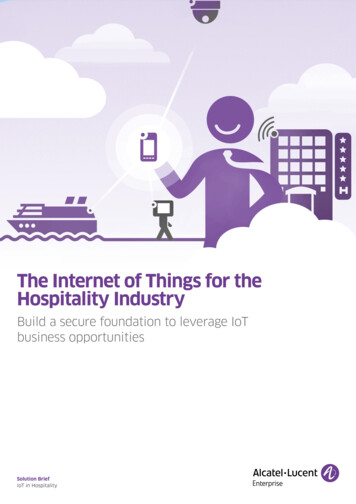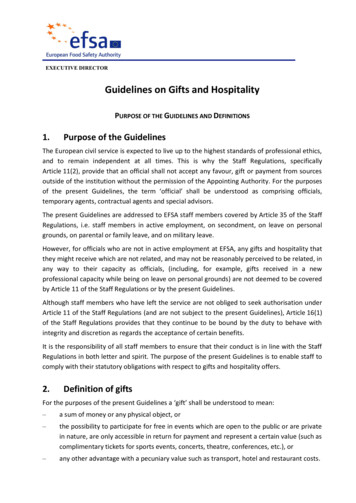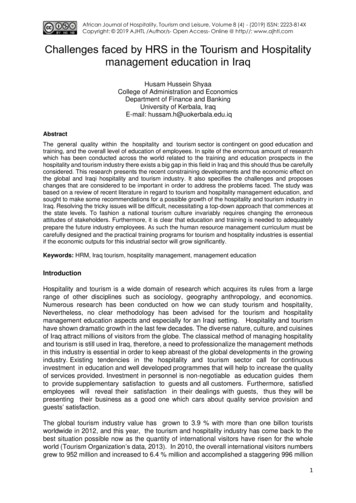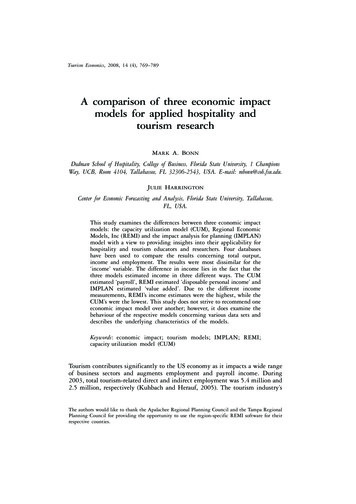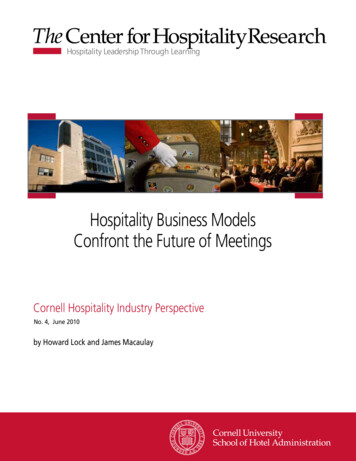
Transcription
Hospitality Business ModelsConfront the Future of MeetingsCornell Hospitality Industry PerspectiveNo. 4, June 2010by Howard Lock and James Macaulaywww.chr.cornell.edu
Advisory BoardRa’anan Ben-Zur, Chief Executive Officer, French QuarterHoldings, Inc.Scott Berman, U.S. Advisory Leader, Hospitality and LeisureConsulting Group of PricewaterhouseCoopersRaymond Bickson, Managing Director and Chief ExecutiveOfficer, Taj Group of Hotels, Resorts, and PalacesStephen C. Brandman, Co-Owner, Thompson Hotels, Inc.Raj Chandnani, Vice President, Director of Strategy, WATGBenjamin J. “Patrick” Denihan, Chief Executive Officer,Denihan Hospitality GroupJoel M. Eisemann, Executive Vice President, Owner andFranchise Services, Marriott International, Inc.Kurt Ekert, Chief Operating Officer, GTA by TravelportBrian Ferguson, Vice President, Supply Strategy and Analysis,Expedia North AmericaChuck Floyd, Chief Operating Officer–North America,HyattAnthony Gentile, Vice President–Systems & Control,Schneider Electric/Square D CompanyGregg Gilman, Partner, Co-Chair, Employment Practices,Davis & Gilbert LLPSusan Helstab, EVP Corporate Marketing,Four Seasons Hotels and ResortsJeffrey A. Horwitz, Partner, Corporate Department,Co-Head, Lodging and Gaming, ProskauerKevin J. Jacobs, Senior Vice President, Corporate Strategy &Treasurer, Hilton WorldwideKenneth Kahn, President/Owner, LRP PublicationsPaul Kanavos, Founding Partner, Chairman, and CEO, FX RealEstate and EntertainmentKirk Kinsell, President of Europe, Middle East, and Africa,InterContinental Hotels GroupRadhika Kulkarni, Ph.D., VP of Advanced Analytics R&D,SAS InstituteGerald Lawless, Executive Chairman, Jumeirah GroupMark V. Lomanno, President, Smith Travel ResearchSuzanne R. Mellen, Managing Director, HVSDavid Meltzer, Vice President of Global Business Development,Sabre Hospitality SolutionsEric Niccolls, Vice President/GSM, Wine Division,Southern Wine and Spirits of New YorkShane O’Flaherty, President and CEO, Forbes Travel GuideTom Parham, President and General Manager,Philips Hospitality AmericasChris Proulx, CEO, eCornell & Executive EducationCarolyn D. Richmond, Partner and Co-Chair, HospitalityPractice, Fox Rothschild LLPSteve Russell, Chief People Officer, Senior VP, HumanResources, McDonald’s USAMichele Sarkisian, Senior Vice President, MaritzJanice L. Schnabel, Managing Director and Gaming PracticeLeader, Marsh’s Hospitality and Gaming PracticeTrip Schneck, President and Co-Founder, TIG Global LLCAdam Weissenberg, Vice Chairman, and U.S. Tourism,Hospitality & Leisure Leader, Deloitte & Touche USA LLPThe Robert A. and Jan M. Beck Center at Cornell UniversityBack cover photo by permission of The Cornellian and Jeff Wang.Cornell Hospitality Industry Perspectives,No. 4 (June 2010) 2010 Cornell UniversityCornell Hospitality Report is produced forthe benefit of the hospitality industry byThe Center for Hospitality Research atCornell UniversityRohit Verma, Executive DirectorJennifer Macera, Associate DirectorGlenn Withiam, Director of PublicationsCenter for Hospitality ResearchCornell UniversitySchool of Hotel Administration489 Statler HallIthaca, NY 14853Phone: 607-255-9780Fax: 607-254-2922www.chr.cornell.edu
Thank you to ourgenerousCorporate MembersSenior PartnersHilton WorldwideMcDonald’s USAwww.hotelschool.cornell.edu/execedPhilips HospitalitySTRTaj Hotels Resorts and PalacesTIG GlobalPartnersThe Office of Executive Educationfacilitates interactive learning opportunities whereDavis & GilbertLLP and world-class Cornell facultyprofessionals from the global hospitalityindustryDeloitte & Touche USA LLPexplore, develop and apply ideasto advancebusinessDenihanHospitalityGroup and personal success.eCornell & Executive EducationExpedia,The Professional Development ProgramInc.Forbes Travel GuideFour Seasons Hotels and ResortsThe Professional Development Program(PDP) is a series of three-day courses offered in finance,Fox Rothschild LLPfoodservice, human-resources, operations,marketing,real estate,French QuarterHoldings,Inc. revenue, and strategicmanagement. Participants agree thatCornelldeliversthemostreqardingFX Real Estate and Entertainment,Inc. experience availableto hospitality professionals. ExpertHVSfacutly and industry professionals lead a program thatHyattbalances theory and real-world examples.InterContinental Hotels GroupJumeirah GroupThe General Managers ProgramLRP PublicationsMarriott International, Inc.Marsh’sHospitalityPractice for hotel genearl managers andThe General Managers Program (GMP)is a 10-dayexperiencetheir immediate successors. In the Maritzpast 25 years, the GMP has hosted more than 1,200PricewaterhouseCoopersparticipants representing 78 countries.Participants gain an invaluable connection to anProskauerinternational network of elite hoteliers.seeks tomove an individual from being aSabreGMPHospitalitySolutionsday-to-day manager to a strategic thinker.SASSchneider ElectricSouthern Wine and Spirits of AmericaThe Online PathThayer Lodging GroupThompsonwhoHotelsOnline courses are offered for professionalswould like to enhance their knowledge orTravelportlearn more about a new area of hospitality management, but are unable to get away from theWATGdemands of their job. Courses are authored and designed by Cornell University faculty, usingthe most current and relevant caseFriendsstudies, research and content.The Custom PathAmerican Tescor, LLC Argyle Executive Forum Berkshire Healthcare Cody Kramer Imports CruiseIndustry News DK Shifflet & Associates ehotelier.com EyeforTravel 4Hoteliers.com Gerencia deHoteles & Restaurantes Global Hospitality Resources Hospitality Financial and Technological Professionals hospitalityInside.com hospitalitynet.org Hospitality Technology Magazine Hotel Asia Pacific HotelChina HotelExecutive.com Hotel Interactive Hotel Resource HotelWorld Network International CHRIE International Hotel Conference International Society of Hospitality Consultants iPerceptions JDA SoftwareGroup, Inc. Lodging Hospitality Lodging Magazine Milestone Internet Marketing MindFolio MindshareTechnologies Parasol PhoCusWright Inc. PKF Hospitality Research RealShare Hotel Investment & FinanceSummit Resort and Recreation Magazine The Resort Trades RestaurantEdge.com Shibata Publishing Co. Synovate The Lodging Conference TravelCLICK UniFocus USA Today WageWatch, Inc. WIWIH.COMMany companies see an advantage to having a private program so that company-specificinformation, objectives, terminology nad methods can be addressed precisely. Customprograms are developed from existing curriculum or custom developed in a collaborativeprocess. They are delivered on Cornell’s campus or anywhere in the world.
Hospitality BusinessModels Confront theFuture of Meetingsby Howard Lock and James MacaulayEExecutive Summaryconomic recovery has been slow to reach many parts of the global hospitality sector, andone of the most sluggish areas to improve has been the meetings and association business.Even as business activity resumes, the recession and other events, including the Icelandicvolcano eruption, have caused firms to review their corporate meeting travel patterns. Inparallel, a significant disruption with profound implications for the hospitality sector is occurring inthe form of technology-enabled business-travel substitution. Corporate travel departments seekinginnovative ways to reduce costs, enhance productivity, reduce carbon footprints, and transform themeeting experience are turning to rapidly maturing video and virtual meeting technologies to replaceconventional transient and event-oriented business travel. Seeing the possibilities for serving thismarket segment, several leading hotel chains have introduced video and virtual meeting technologiesas lines of business. For companies willing to adapt, new strategies and business models to capitalize onthis disruption will drive competitive advantage and greater market share.4The Center for Hospitality Research Cornell University
About the AuthorsHoward Lock is the global practice lead for Hospitality at Cisco’s Internet Business Solutions Group (IBSG),the company’s global strategy consultancy (hlock@cisco.com). Lock works with the world’s largest hospitalityand gaming organizations to help transform their business models, improve profitability and productivity, andintroduce innovative solutions.James Macaulay is a director with the Economics Practice of the Cisco Internet Business Solutions Group (IBSG),where he heads the organization’s research team. Macaulay examines the impact of IT across industries, with afocus on innovation, customer experience, and collaborationCornell Hospitality Industry Perspectives June 2010 www.chr.cornell.edu5
COrnell Hospitality Industry PerspectivesHospitality Business ModelsConfront the Future of MeetingsAby Howard Lock and James Macaulayfter two dismal years, hospitality leaders anticipate that when the economy recovers, sotoo will the income statements of hotel operators. There is much ground to be madeup. While recent results have been cause for optimism, business travel is downprecipitously from the levels of prior years (down 12 percent in 2009 alone).1 Grouptravel has been particularly weak in recent quarters, and the unprecedented flight cancellations causedby the April 2010 Icelandic volcano eruption also caused travel managers to reconsider their travelarrangements.2 Recent research suggests that just as the shock of 9/11 “reset” the relationship betweenthe wider economy and lodging demand, so has the Great Recession set a different economic benchmark.This lower-level relationship may be long lasting.31 C. Jones, “Companies must decide: Is a business trip worth it?” USA Today, April 15, 2010 (statistics from Mike McCormick, executive director of theNational Business Travel Association).2 For example, see: Tarmo Virki and Erica Billingham, “Air traffic bans boost video conferencing: Cisco,” Reuters, April 19, 2010 (www.reuters.com/article/idUSTRE63I4ZC20100419).3 See: “Timetable for Hotel Recovery Hinges Greatly on GDP,” National Real Estate Investor, March 11, 2009; and “Magnuson Hotels: What to Do About‘the Shift,’” Hospitality Net, September 9, 2009.6The Center for Hospitality Research Cornell University
Against this backdrop, technology-driven travel substitution has been and will continue to be an important factordisrupting business and group travel patterns. The 2008–09recession compelled companies to reduce expenditures acrossthe board, including those for business travel. As a result,many organizations turned to alternative arrangements suchas technology-based meetings in the hope of reducing traveland entertainment costs.For some time, the hospitality industry has acknowledged that travel substitution arising from technologicalinnovation could have negative consequences on occupancy. With increased use of video (both on-demand andlive streaming) and the advent of virtual meeting technologies, however, there is further justification for re-examiningpotential near-term impacts of information technology onhospitality industry income. Gartner, Inc., predicts that videobased meetings will replace 2.1 million airline seats per yearby 2012, representing a net revenue decline of 3.5 billion forthe travel and hospitality industries.4 A recent study by theNational Business Travel Association found that 81 percentof respondents believe technology serves as a replacementfor business trips.5To begin with, we must revisit the assumption thathotel demand is waiting in the wings. We know that companies turned to technology-based meetings as a temporary measure to control expenditures during the downturnand to conduct meetings during the volcano’s lengthyground hold. But what if technology-based meetings aredeemed enduring substitutes for business travel? It is hardto believe that companies will be willing to surrender costsavings when viable alternatives have emerged to preservethem.This article from the Cisco Internet Business Solutions Group (IBSG) explores key developments thatwill create significant shifts in the hospitality and travelindustry; discusses the threats posed by video and virtualmeetings; provides real-world examples of how video andvirtual meeting technologies are being used today; and4 “Gartner’s Top Predictions for IT Organizations and Users, 2009 and5 “2009 Business Travel Overview and Cost Forecast,” National BusinessBeyond: Where Is the Money?,” February 4, 2009, Gartner, Inc.Travel Association, April 13, 2009.Cornell Hospitality Industry Perspectives June 2010 www.chr.cornell.edu7
Exhibit 1Expectations for increased use of meeting technologies, 2009–2010Alternative Meeting Methods ExpectedTo Be Used More in 2009-1060%54%48%50%40%30%30%27%25%20%10%0%5%Online WebinarsTeleconferencingVideoconferencing Hold Face-to-Face outlines emerging opportunities for hoteliers. The analysisdraws on (1) Cisco’s experience deploying technologybased meeting solutions, such as Cisco TelePresence, 6 and(2) Cisco IBSG’s engagements with leading companiesaround the world.Three Key DevelopmentsEnterprise Adoption of Video and Collaboration TechnologiesAcceleratesVideo is emerging as the next frontier in technology innovation, with YouTube, Skype, and advanced mobile networksmaking pervasive access to video the norm. IDC estimatesthat a typical employee watches 6.8 hours of enterprise videoat work per month.7Although the effects of conventional video conferencingon business-travel substitution have been relatively modest6 Cisco TelePresence is an innovative technology that combines richaudio, high-definition video, and interactive elements to deliver an “inperson” experience over the network.7 “Video in the Enterprise Proliferates: An Updated Snapshot of Currentand Planned Adoption,” IDC, September 2009.8OtherNoneto date, the potential for technology-driven substitution mayhave reached an inflection point.8 Coincident with reductions in travel spending, companies have grown accustomedto alternative meetings, with largely favorable results, andusage has increased substantially.9 The number of onlineand video-based meetings has soared in the past two yearsas companies place more pressure on managers to makedo with less (see Exhibit 1), leading to increased adoption8 Jin-Long Lu and Srinivas Peeta, “Analysis of the Factors that Influencethe Relationship Between Business Air Travel and Videoconferencing,”Transportation Research Part A: Policy and Practice, 2009; Jon MartinDenstadli, “Impact of Videoconferencing on Business Air Travel: TheNorwegian Experience,” Journal of Air Transport Management, Vol. 10,No. 6 (November 2004), pp. 371–376, 2004; Alan R. Bender and FrederickJ. Stephenson, “Contemporary Issues Affecting the Demand for BusinessAir Travel in the U.S.,” Journal of Air Transport Management, Vol. 4, No. 2(April 1998), pp. 99–109; Jacques Roy and Pierre Filiatrault, “The Impactof New Business Practices and Information Technology on BusinessAir Travel Demand,” Journal of Air Transport Management, Vol. 4, No. 2(April 1998), pp. 77–86.9 “True Collaboration Key to Videoconferencing Adoption,” In-DustryUpdates, In-Stat, December 2008.The Center for Hospitality Research Cornell University
Exhibit 2Corporate adoption of video technologiesUse nowDeploy within 1yearTest within 1 yearNo plansDon’t knowRoom and executivevideoconferencing76%8%5%6%5%Personal videophones17%3%22%47%11%PC-based desktop videoconferencing(webcam with PC software)50%18%17%9%5%Telepresence suites12%9%14%57%8%Source: Wainhouse Research, July 2009of video-based technologies (see Exhibit 2). In addition toCisco, other players in the high-definition video communications space include Hewlett-Packard Company; LifeSizeCommunications, Inc.; Polycom, Inc.; and Teliris, Inc.10Video communication is closely linked to anothertechnological innovation affecting travel: Web 2.0-basedcollaboration tools. Web 2.0—which encompasses a range ofpopular internet venues such as Facebook, LinkedIn, Twitter,and YouTube—is an amalgam of online capabilities, generally associated with new forms of multimedia communication,information sharing, and social networking. Communication and collaboration tools are similarly a composite of several high-growth software and services markets, including: web conferencing and messaging (for example, enterprise instant messaging, presence-aware applications,and “single in-box” unified communications for email,voicemail, and fax); integrated collaboration environments (also known as“groupware”); and team collaboration applications such as wikis, blogs,and social networking for the enterprise.According to IDC, the global market for corporatecollaboration applications will exceed 10 billion by 2012.11While the direct effects of Web 2.0-based collaboration toolson travel substitution may be limited, they are importantsignposts of a growing demand for new forms of technologyenabled interaction that will further influence users’ expectations for how meetings are conducted.Innovative Technologies Increase the Rate ofBusiness-Travel SubstitutionCompanies are increasingly relying on video and virtualmeeting technologies to cut costs, reduce carbon footprints,and improve productivity. Cisco has made significant stridesin using its own video communications and collaborationsolutions companywide to achieve these goals. With morethan 65,000 employees globally, Cisco has 700 TelePresencerooms in nearly 50 countries. Employees, partners, andcustomers use these rooms an average of 4.6 hours a day—far more time than was spent using conventional videoconferencing systems.12In the first three and a half years of deployingTelePresence, Cisco has held more than 230,000 meetings—11 “Worldwide Collaborative Applications 2009–2013 Forecast Update10 “Logitech Completes Acquisition of LifeSize Communications,” www.logitech.com/index.cfm/172/6537&cl usand 2008 Vendor Shares,” IDC, September 2009.12 Cisco IT and Cisco IBSG analysis, January 2010.Cornell Hospitality Industry Perspectives June 2010 www.chr.cornell.edu9
Companies are increasinglyrelying on video and virtualmeeting technologies tocut costs, reduce carbonfootprints, and improveproductivity.some 74,000 of which helped avoid travel, according to postmeeting surveys completed by employees. To date, travelavoidance has yielded more than 400 million in savingsand more than 150 million in workforce productivitygains. TelePresence meetings have also reduced Cisco’sgreenhouse gas emissions by 225,000 metric tons over thisperiod. Coupled with policy changes on internal travel,communication and collaboration technologies enabledCisco to reduce travel expenses from 750 million in fiscalyear 2008 to 240 million in fiscal year 2009.13Cisco has more than 500 TelePresence customers, including thirty Fortune Global 100 companies. Together theyrepresent more than 3,300 TelePresence meeting rooms. Customers include AT&T, which reportedly reduced employeeair miles by 15 percent through extensive use of video andweb-based meetings.14 British Telecom eliminated 860,000face-to-face meetings, slashed travel costs by more than 20million, increased productivity by more than 150 million,and reduced the company’s carbon footprint by 96,000 metric tons.15 Procter & Gamble cut travel expenses by millionsof dollars, eliminating 6,000 flights in the first six months ofusing TelePresence.16Information Technology Recasts the MeetingExperienceExecutive Conference: A Flagship for Virtual MeetingsCisco has conducted virtual meetings since 1999, althoughprimarily in the form of audio and video on demand andslide sharing. Like other companies, in years past Cisco typically held its corporate events in person. In the wake of theeconomic downturn and with the proliferation of communication and collaboration technologies, Cisco has sought newways to streamline business travel and transform the meetingexperience for greater productivity and impact.Cisco’s Strategic Leadership Offsite (SLO) is an exampleof a meeting transformed by technology. Cisco has conducted SLO each year for the past two decades, allowing executives to discuss company priorities, vision, and strategies forthe coming year. In the second quarter of 2009, the company conducted the entire two-day event online in a virtualenvironment designed to emulate the look and feel of theExecutive Briefing Center at Cisco’s headquarters, in San Jose,California. Participants from around the globe joined viaCisco TelePresence links and Cisco WebEx conference calls.13 Ibid.14 “Within five years, technology will obliterate the need for businesstravel,” Fast Company, July 25, 2008.15 “BT Saves 238M with Video Conferencing,” BusinessGreen.com, January 15, 2008.16 “P&G Finds a Green Alternative to Travel in Telepresence,” InfoWorld,April 20, 2009.10The Center for Hospitality Research Cornell University
Exhibit 3Global sales experience home page features host avatarSource: Cisco, 2009Breakout sessions for smaller groups were held in onlinemeetings using Cisco WebEx collaboration technology. Distributed teams worked together on key business issues with asenior Cisco leader, employing voice over IP, screen sharingand virtual whiteboards, and video from desktop webcams.Some 3,100 Cisco executives participated virtually inthe 2009 meeting, versus 2,700 at the in-person 2008 event.Those who could not join virtual SLO were able to watchvideos of recorded sessions, proceedings, and other richmedia content afterward.Technology also transformed the nature of the meeting. For example, Cisco Chairman and CEO John Chambersreceived more than 430 questions from attendees during one30-minute moderated chat session—far more questions thancould have been raised during an in-person presentation.New capabilities led to a more interactive, personalized, andcontent-rich experience for both participants and presenters.Virtual SLO also contained more than 150 executive-hostedsessions, eight guest speakers, and twice the amount of leadership content as at past in-person meetings.Cost benefits were significant. In 2008, cost per participant was 2,800; in 2009, that figure was 680. Of interest tothe hospitality industry, this virtual meeting saved money inair and ground travel, hotel rooms, food and miscellaneousexpenses, and reduced fees for convention space. The virtualapproach also enabled Cisco to decrease its carbon footprintfor SLO by roughly 90 percent. Overall, travel times declinedby 90 percent—an enormous gain in terms of recoveredproductivity.Virtual Meeting Goes GlobalFollowing the successful experience of SLO, Cisco conducted a substantially larger event in August 2009, hosting itsannual sales conference entirely through a virtual environment called the Global Sales Experience (GSX; see Exhibit3). With 19,000 participants from 89 countries and 24 timezones, GSX had five times more attendees than SLO. In prioryears, the sales conference was held at large hospitality andconvention venues around the United States. In 2009, theexperience was completely virtual; not one person had topack a suitcase, board a plane, or leave his or her office.The GSX environment employed a full palette of technology-based collaboration and video solutions, including ahost avatar, participant polling using mobile devices, virtualdiscussion forums, instant messaging, a virtual “briefcase”(for downloading PDF and multimedia versions of eventCornell Hospitality Industry Perspectives June 2010 www.chr.cornell.edu11
Virtual Meetings: The Tata ExperienceGiven the growth of virtual meetings, Tata Communications saw thepotential of combining technology innovation with the physical realestate and brand of hotels by introducing public Cisco TelePresencerooms located at key hotel properties in major business centers.These facilities enabled business customers to use the TelePresencesystem without the expense of purchasing the technology itself.Working with Taj, Starwood, and Rendezvous, among others, TataCommunications demonstrated to hoteliers the potential return oninvestment and a strengthened value proposition from this service.Tata Communications would build a TelePresence room in the hotel,allowing connections to a growing network of rooms globally. Tataalso provided an online reservations portal with e-commercecapabilities and full concierge and management services of therooms. The hotels in turn provided the space, and shared on-sitestaffing and sales and marketing commitments. The hotels were alsoable to tap into Tata’s established relationships with AmericanExpress Travel and Carlson Wagonlit Travel, as well as partners in thelocal community, as sales channels for TelePresence services.Tata initially found limited interest in this arrangement because theconnection coverage was restricted largely to India. As the networkgrew, so did utilization. One particularly important source ofbusiness was enterprises that already had their own TelePresencerooms but wanted to extend their reach with Tata’s public rooms.Other companies relied wholly on the public rooms, including Arup,the global design and engineering firm, which saved time andresources by conducting board meetings via TelePresence.TelePresence endpoints are typically available by the hour. Customersin hotels can connect to other public rooms, or to privately ownedTelePresence rooms of any customer on Tata Communications’managed services network.Tata Communications has expanded its network from four rooms in2008 (in Bangalore, Chennai, and Mumbai) to fourteen rooms inearly 2010, including one in Toronto. Further expansion to Europe,North America, Asia Pacific, and Africa will continue later in 2010,with over 30 rooms expected by year’s end.For hoteliers wishing to explore TelePresence as a service for theirhotels, Tata suggests examining the following three issues:(1) Is your property located centrally with proximity to majorcorporate offices?(2) Do you have a well-located space within your property that canbe converted to a TelePresence room?(3) Do you have sales and marketing resources that can work incollaboration with a community of partners to promote yourTelePresence facility and the entire network?proceedings, agendas, product brochures, and trainingmaterials), note-taking tools, interactive games, video blogs,video on demand, live video conferences, and feeds fromCisco TelePresence. The user interface was a virtual convention space, in which participants “moved” from concourseto plenary sessions to “solutions booths,” where they couldinteract with fellow employees and download content ofinterest.More than 200 separate sessions and 88 hours ofconsecutive content were shared over a three-day period,including product and service showcases, live executive sessions, and sales recognition events. Results were astonishing: Cisco saved more than 90 percent of the costs spenton a typical physical gathering, eliminated 211 million airmiles and 334,000 hours of travel time, and averted 84,400metric tons of greenhouse gases.Not surprisingly, Cisco now holds most of its keyevents, such as marketing road shows and customer andpartner education sessions, either entirely virtually or witha strong virtual component. Participant satisfaction scoreshave been high and are improving. The virtual SLO andGSX events provide a hard business case for travel avoidance, while affording a cutting-edge event experience.New Business Models EmergeWhile not all meetings can be held remotely, and face-toface meetings will certainly endure,17 Cisco’s experience underscores why the hotel industry must prepare for a comingsea change in how meetings are conducted. The increasingprominence of technology-based meetings in both transientand event-based businesses presents a new playing field forhospitality operators, in which virtual and physical meetings commingle to serve the needs of corporate customers.Some hotel operators have already begun initiatives to hostvideo and virtual meetings, including Marriott International, Starwood Hotels and Resorts Worldwide, and Taj Hotels,Resorts, and Palaces. Technology and the market movequickly, so time is of the essence in establishing a hotel’sbrand association around the next generation of meetings.TelePresence as a ServiceTelePresence as a Service (TPaaS) allows third-party operators (such as hotels) to integrate video meetings into hospitality business models. With TPaaS, meeting participantsuse Cisco TelePresence in another firm’s facilities ratherthan purchasing the equipment themselves. In this way,17 Research suggests face-to-face meetings are considered most criticalfor in-depth negotiations, finalizing sales agreements, recruiting forsenior positions, or relationship-building with important clients. See,for example: “Managing Across Distance in Today’s Economic Climate:The Value of Face-to-Face Communications,” Harvard Business Review,August 2009; and “Business Meetings: The Case for Face-to-Face,” ForbesInsights, June 2009.12The Center for Hospitality Research Cornell University
enterprises and small businesses have access to TelePresenceresources without the attendant capital costs.Telecommunications service providers are also activelytargeting this space. Tata Communications was an earlyinnovator, opening the first of twelve planned public CiscoTelePresence suites in India and the United States (see thebox on the previous page). Tata was also first to establisha global network of public Cisco TelePresence rooms, andhas plans to deploy TPaaS in more than 40 major centersand to open several dozen more suites in partnership withStarwood.18AT&T, which is also at the forefront of TelePresenceinnovation, has partnered with Marriott and Cisco to deployTelePresence capabilities in Marriott’s “GoThere VirtualMeetings” studios at properties in New York and Washington, D.C
Cornell University School of Hotel Administration 489 Statler Hall Ithaca, NY 14853 Phone: 607-255-9780 Fax: 607-254-2922 www.chr.cornell.edu Back cover photo by permission of The Cornellian and Jeff Wang. Ra'anan Ben-Zur, Chief Executive Officer, French Quarter Holdings, Inc. Scott Berman, U.S. Advisory Leader, Hospitality and Leisure .



